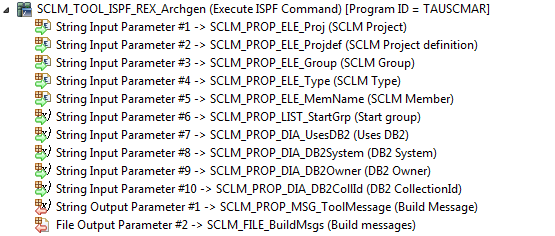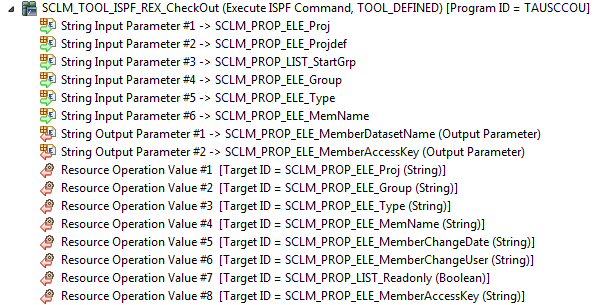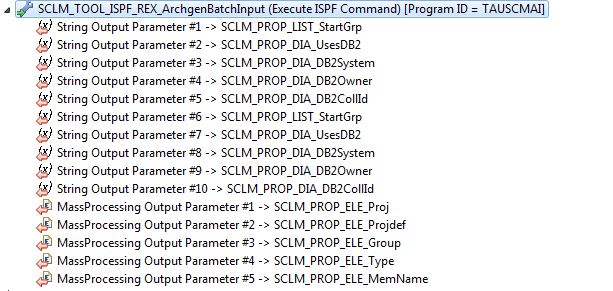Relationship: Tool Has Output Parameter
Output parameters of tools are described by the Tool has Output Parameter relationship.
The output parameters of a tool are temporarily saved during the execution of an action, so that subsequent tools can use them as input parameters.
The way in which the output of a tool should be interpreted can be modeled via the type attribute. Depending on the type, a property or a file descriptor must be referenced via the relationship.
- Type = String
- Default value. The output is assigned as a property value of the referenced property.
- Type = File
- A tool output that is modeled with the File type is interpreted as a file name. You must reference a file descriptor. If a physical name (Name_Physical) is modeled for the referenced file descriptor, it is temporarily overwritten. The output parameter contains the name of the file, and the referenced file descriptor defines the type and the structure of the file.
Attributes of tool output parameters:
| Attribute | Type | Description |
|---|---|---|
| Mass Processing | Boolean | If set to false, the parameter is written to the single context. If set to true the output is written to the mass context. |
| TargetIDFile[D] | File Descriptor | Reference to a file descriptor. This is only visible if the type attribute has been set to “File”. |
| TargetIDParm[D] | Property | Reference to a property. This is only visible if the type attribute has been set to “String”. |
| Label [O] | String | The display text of the parameter in the Output dialog box. |
| Type | Selection | Determines how the output parameter should be interpreted.
Valid values include:
|
Tool output parameters of deprecated tools created before Enterprise Developer 5.0 have the following attributes:
| Attribute | Type | Description |
|---|---|---|
| TargetIDFile[D] | File Descriptor | Reference to a file descriptor. This is only important if the type attribute has been set to “File”. |
| TargetIDParm[D] | Property | Reference to a property. This is only important if the type attribute has been set to “Element” or “String”. |
| Label [O] | String | The display text of the parameter in the Output dialog box. |
| Type | Selection | Determines how the output parameter should be interpreted.
Valid values include:
Default value is string. |
| ToOutputDialog [O] | Boolean | Indicates whether the parameter should be displayed in the Output dialog box at the end of the action. This only takes place if there is an Output dialog modeled at the end of the tool sequence. |
| Ui Category [O] | String | Categorizes the parameter in the Output dialog box. Categorized parameters are enclosed in a labeled frame. Successive parameters with the same categories are enclosed by the same frame in the Output dialog box. See The "UI Category" Attribute for more information. |
| Ui Resizable | Boolean |
Specifies whether a dialog field can be resized or not. Properties of types Boolean, TextArea and TextArray cannot be set to be resizable. The default value is true. |
Examples


The tool SCLM_TOOL_ISPF_REX_CheckOut is an example of a tool with output parameters of type ToolDefinedResourceOperation. The tool has to return a resource operation statement containing the resource operation to be performed and a value for every modeled output parameter of type ToolDefinedResourceOperation. See Tool-defined Resource Operations for more information. In this case, the tool is an ISPF REXX tool which has to return the resource operations in the ISPF table TAUTOTBI.

The tool SCLM_TOOL_ISPF_REX_ArchgenBatchInput is an example of a tool with output parameters of type String and of type MassProcessing. The tool provides the input for a succeeding tool to generate SCLM architecture definitions for a group of SCLM elements. The MassProcessing output parameters of this tool are mapped to the MassProcessing input parameters of the succeeding tool. If the tool is an ISPF REXX tool, the MassProcessing output parameters have to be returned in the ISPF table TAUTOTOP.